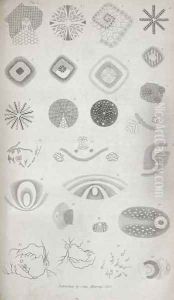Jan Purkinje Paintings
Jan Evangelista Purkyně, born on December 17, 1787, in Libochovice, Bohemia (now Czech Republic), was a pioneering Czech physiologist and neuroscientist, rather than a figure traditionally associated with the realm of visual arts. Despite this, his work significantly intersected with the study of visual perception, making him a notable figure in the broader landscape of the history of science and its impact on understanding visual phenomena.
Purkyně's academic journey began at the University of Prague where he initially studied philosophy before shifting his focus to medicine. His deep interest in the microscopic structure of tissues and organs, particularly the human brain and the eye, led him to significant discoveries that would influence not only physiology but also the nascent field of cellular biology. His doctoral thesis in 1819 presented groundbreaking observations on the phenomenon of visual perception, including descriptions of what would later be named after him: Purkinje images—reflections of objects from structures of the eye, and the Purkinje effect—the shift in brightness of colors seen under low light conditions.
Throughout his career, Purkyně held several academic positions, most notably at the University of Breslau (now Wrocław, Poland), where he established one of the first physiology laboratories in Europe. His explorations extended beyond the nervous and visual systems, venturing into pharmacology, embryology, and the study of fingerprints, among other areas. His interdisciplinary approach helped lay the foundations for modern experimental physiology.
Purkyně's contributions to science were vast and varied, but his work on vision and his investigations into the patterns of human fingerprints left an indelible mark on the fields of physiology, psychology, and forensic science. He was a member of numerous scientific societies and received several honors in his lifetime. Jan Evangelista Purkyně passed away on July 28, 1869, in Prague, leaving behind a legacy that bridged the worlds of science and art, particularly through his profound influence on our understanding of visual perception.
